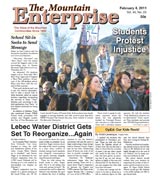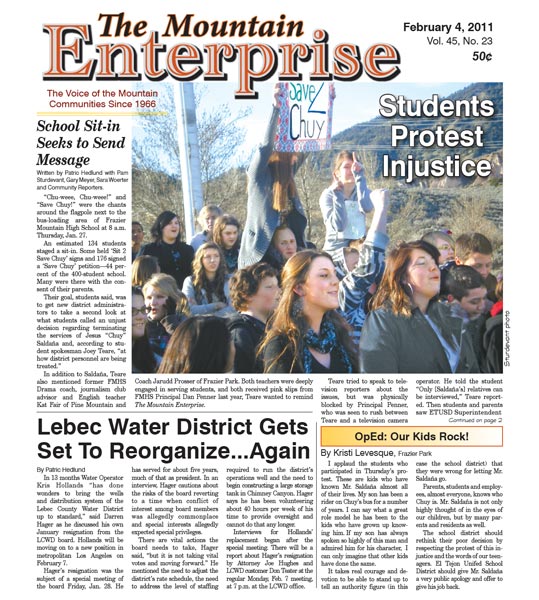![About 55 residents of Neenach, Fairmont, Antelope Acres, Holiday Valley, and the Lakes gathered at the WeeVill Market January 20 to hear from two renewable resource energy energy developers. Here, a group standing in product rows and sitting in the diner area review images provided by NextEra Energy about their wind turbine project. [Photo by Patric Hedlund for The Mountain Enterprise ]](https://mountainenterprise.com/fds/images/story/fs_8166.jpg)
Image 1 of 4
About 55 residents of Neenach, Fairmont, Antelope Acres, Holiday Valley, and the Lakes gathered at the WeeVill Market January 20 to hear from two renewable resource energy energy developers. Here, a group standing in product rows and sitting in the diner area review images provided by NextEra Energy about their wind turbine project. [Photo by Patric Hedlund for The Mountain Enterprise ]![At right, Thomas Eisenhauer of Renewable Resources Group from Wilshire Bouleveard in Los Angeles with (left) technology partner Ed Smeloff of SunPower Corp. speak about their Antelope Valley Solar farm project which straddles the Kern County and L.A. County lines. Kern County will be the lead agency in their Environmenal Impact Review under CEQA. [Photo by Patric Hedlund for The Mountain Enterprise ]](https://mountainenterprise.com/fds/images/story/fs_8166_2.jpg)
Image 2 of 4
At right, Thomas Eisenhauer of Renewable Resources Group from Wilshire Bouleveard in Los Angeles with (left) technology partner Ed Smeloff of SunPower Corp. speak about their Antelope Valley Solar farm project which straddles the Kern County and L.A. County lines. Kern County will be the lead agency in their Environmenal Impact Review under CEQA. [Photo by Patric Hedlund for The Mountain Enterprise ]![Dave Kerr of the Fairmont area has been elected president of the Fairmont Town Council at the end of last year. He is an L.A. County Sheriff's deputy serving as bailiff in a Lancaster court. The council and two other groups of residents have filed two appeals with L.A. County Regional Planning Commission against an energy developer (Alpine Solar NRG) that did not prepare an Environmental Impact Review before receiving a Conditional Use Permit to begin building in their area.[Photo by Patric Hedlund for The Mountain Enterprise ]](https://mountainenterprise.com/fds/images/story/fs_8166_3.jpg)
Image 3 of 4
Dave Kerr of the Fairmont area has been elected president of the Fairmont Town Council at the end of last year. He is an L.A. County Sheriff's deputy serving as bailiff in a Lancaster court. The council and two other groups of residents have filed two appeals with L.A. County Regional Planning Commission against an energy developer (Alpine Solar NRG) that did not prepare an Environmental Impact Review before receiving a Conditional Use Permit to begin building in their area.[Photo by Patric Hedlund for The Mountain Enterprise ]![About 55 residents of Neenach, Fairmont, Antelope Acres, Holiday Valley, and the Lakes gathered at the WeeVill Market January 20 to hear from two renewable resource energy energy developers. [Photo by Patric Hedlund for The Mountain Enterprise ]](https://mountainenterprise.com/fds/images/story/fs_8166_4.jpg)
Image 4 of 4
About 55 residents of Neenach, Fairmont, Antelope Acres, Holiday Valley, and the Lakes gathered at the WeeVill Market January 20 to hear from two renewable resource energy energy developers. [Photo by Patric Hedlund for The Mountain Enterprise ]
By Patric Hedlund
It takes guts for a preppy guy from Wilshire Boulevard in Los Angeles to jump in front of a roomful of hard-bitten desert rats to talk about his plans for a photovoltaic solar farm.
Thomas Eisenhauer and his Los Angeles-based Renewable Resources Group has purchased fallow farmland in the Rosamond-Antelope Valley area that is bisected by Southern California Edison’s Renewable Transmission Project high voltage power lines.
Eisenhauer was eager to tell the Fairmont Town Council all about his plans at a meeting at the WeeVill Market January 20.
In his first breath he assured the community that his company intends to do a full environmental impact review, following the California Environmental Quality Act (CEQA) guidelines.
But it was clear that Eisenhauer wasn’t prepared for the skepticism he encountered from the 55 people sitting at tables and standing among the rows of product shelving, next to racks of Pampers, canned peaches and Nyquil.
What Eisenhauer didn’t fully grasp is that he was perceived to be part of an invading force that has descended upon this dusty high desert region. After years of theory and debate about alternative power, 2011 is the crossover point, and this is ground zero.
In 2008 Governor Arnold Schwarzenegger issued an Executive Order requiring 33 percent of the state’s electricity to be secured from renewable resources by 2020. In 2009, 14 percent of the state’s energy was from such sources.
The target for 2010 was 20 percent. Now electric utilities such as Southern California Edison (SCE) have only nine years left to gear up to generate a full 33 percent of their electricity from renewable resources.
So at the end of last year, a roomful of Sacramento energy wonks took out their maps and traced a line that followed high power transmission grids past areas of the state that have expanses of open land with minimal development.
The wind farms along the ridges of the Tehachapi Mountains have already blazed the way. Now it appears the valley to the south, a place where Los Angeles and Kern Counties meet, is strategically located to benefit from the high tension transmission infrastructure that carries juice to Los Angeles and parts north.
The California Renewable Energy Zones (CREZ) chart unveiled in Sacramento last November targets the places with the “fewest number of environmental concerns and the lowest cost per unit of energy production.”
The CREZ group drew a circle around a place in the Western Antelope Valley, looked up its name on the tax rolls, labelled it “Fairmont” and it is now one of California’s top three locations for generating renewable solar and wind energy.
Suddenly, Fairmont (which has a small market but no town bearing its name), is a rock star on the CREZ charts. Residents report they have tracked 10 companies currently seeking permits in their immediate neighborhood and 33 seeking permits in the vicinity.
Some of the plans, such as that for Eisenhauer’s Antelope Valley Solar, straddle both Los Angeles and Kern County lines. His facility is three-quarters in Kern County (nine miles west of Rosamond) and one-quarter in L.A. County. He and his colleagues came prepared with a thorough Powerpoint introduction and handouts.
But with so many company representatives popping up, all with similar-sounding company names that seem to shift and morph constantly, residents are apprehensive.
Many of those who live in the Neenach-Fairmont area say they fear that Kern and Los Angeles County politicians will be puppets of big energy interests. Their apprehensions are based on evidence.
On December 10 Antelope Acres resident Susan Zahnter wrote to the Los Angeles County Department of Regional Planning to catalogue why their Joshua tree woodland habitat had been designated a significant ecological area (SEA). She argued that “a dangerous precedent would be set” if the “utility- scale project” proposed by an earlier solar farm group, Alpine Solar (NRG), was allowed a conditional use permit (CUP) with no requirement for an environmental impact review under CEQA.
On December 21 the county granted the company their Christmas wish—a CUP with no CEQA review.
Residents began the new year raising money to file two separate appeals. They asked for a March 30 hearing before the commission.
Precedents matter to them, they say, because it is the cumulative impact of so much construction and so many energy projects potentially being built in such a short time that make them cautious.
Antelope Valley Solar says it expects up to 650 jobs will be created during 36 months of construction for this one project alone. Multiply that by 33, and the impacts begin to be considerable.
Kern County is the lead agency for Eisenhauer’s project, although they must secure permits from both counties.
Director of Kern County’s Planning Department, Lorelei Oviatt said in December that Kern’s renewable energy projects are on a fast-track. They want to put the environmental impact reports (EIRs) out quickly.
Many of the development projects are counting on financial incentives from state and federal governments. The goal of the incentives is to mobilize building to begin quickly. Although renewable energy developers recently won an extension in the incentive payment schedule, all the players know they are on a ticking clock.
The economic pressures on politicians are obvious. In his State of the County Address January 19, Chairman of the Kern County Board of Supervisors, Mike Maggard, devoted almost half of his speech to cataloguing the energy projects his county is hoping will bring jobs and tax income back to the county’s recession-gutted 8,000 square miles. Unemployment levels here have recently been twice the national rate.
“The commercial application of solar energy moved from concept to reality last year with 153 megawatts of project approvals in Kern County,” Maggard said. In all, Kern County has 224 megawatts of renewable generation online with 2,800 megawatts soon to come. He said Kern County projects are scheduled “to provide 10,000 megawatts of renewable energy power by 2015, creating an estimated 8,000 construction jobs, 1,500 operational jobs and up to $25 billion of investment….”
L.A. County politicians are also looking at the metrics. With this kind of talk in the background, the people gathered in the WeeVill Market for the Fairmont Council presentations began to ask, logically, “what’s in it for us?”
SEE PART THREE IN THE SERIES
This is part of the February 04, 2011 online edition of The Mountain Enterprise.
Have an opinion on this matter? We'd like to hear from you.


